20th Anniversary Issue: Portraits
October 1st 2013
The success of the Asia-Pacific airline industry in the last two decades can, in no small way, be attributed to the outstanding efforts of many talented and dedicated chief executives. In this anniversary issue we pay tribute to some of them in our …
Portraits of PowerRead More »
DR CHEONG CHOONG KONG
CHEW CHOON SENG
Singapore Airlines (SIA) is a powerhouse in the aviation world. For many years it was the most profitable airline in the world and its inflight product has always been the standard by which other airlines are judged.
It has never posted a full-year loss since going public 30 years ago.
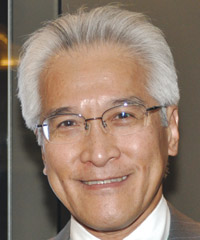 |
Launched in 1972 – it had previously been part of Malaysia-Singapore Airlines with what was to become Malaysia Airlines – two people have stood out in its history. Dr Cheong Choong Kong, a former mathematics professor, joined the carrier in 1974 and became its managing director 10 years later.
He remained in the position until 2003 when Chew Choon Seng (pictured), another name synonymous with the success of SIA, took over the mantle for the next seven years.
Dr Cheong saw the carrier develop from small regional beginnings to a worldbeater. In 1995, SIA ordered an Asia record of 77 B777s (34 firm, 43 options) in a deal worth $12.7 billion. Analysts gasped at the visionary audacity of the huge deal
In 2000, with Cheong still at the helm, SIA became the launch customer for the A380, then known as the A3XX, when it ordered 10 of the aircraft, with 15 options worth $8.6 billion. In a major shopping spree SIA also signed up for six B747-400s with options on nine more, from Boeing.
For Chew the challenges were different. He steered SIA through the toughest time in its history. The industry was still coping with the fall-out from 9/11, the Iraq War and the SARS epidemic when he took over. The global economic downturn of 2007-2008 created additional hardships.
Chew took it all in his stride and was held in high regard by staff. His golden moment came with the delivery of the first A380 and its first commercial flight on October 25, 2007. He called it “the queen of the skies”.
Today, Dr Cheong is chairman of the Overseas Chinese Banking Corporation in Singapore. Chew is chairman of the Singapore Exchange and Singapore Tourism Board.
Dr Cheong was Orient Aviation’s Person of the Year in 1998. Chew received the award in 2006.
SIR ROD EDDINGTON
Sir Rod had the distinction of heading three airlines within 14 years. He was managing director (MD) of Cathay Pacific Airways from 1992 to 1997 capping a 17-year career at the airline. During this time, Cathay underwent the greatest changes in its history as it grew from a small regional carrier into one of the top five most profitable in the world.
 |
As MD, Sir Rod oversaw the introduction of the first Airbus aircraft into the fleet, when nine A330-300s started to arrive in 1995, and the launch of a new corporate identity.
In January, 1997, Sir Rod was appointed executive chairman of Ansett Australia, He was seen as a steady hand that would oversee the sale of the carrier and its development as an airline. It didn’t happen. Ansett collapsed four years later, one year after Eddington left the airline in 2003 to replace Bob Ayling as CEO of British Airways (BA).
Following a loss of £200 million (US$310 million) in 2002, Eddington’s cost-cutting programme allowed BA to report a profit of £135 million in 2003, a good result as many of its rivals faltered in the months following 9/11.
What was not so popular was Sir Rod’s decision to permanently retire the British Airways Concorde in 2003. He was knighted in 2005 for his services to the aviation industry.
Today, he lives in Australia and serves on the board of several blue chip companies.
TONY FERNANDES
Asia’s low-cost pioneer. In 2001, Fernandes bought cash-strapped, full service Malaysian carrier, AirAsia, for the sum of one Malaysian ringgit ($0.26) and re-launched it as Asia’s first LCC. There were no shortage of naysayers at the time, but the airline carried 800,000 passengers in less than a year and a confident Fernandes was talking of doubling his fleet to 13 aircraft.
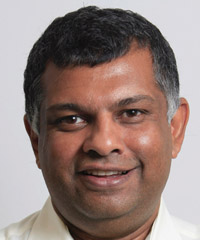 |
Today, AirAsia, which has subsidiary carriers in Indonesia, Thailand, the Philippines, Japan and India, has 125 aircraft in service with another 350 on order. Fernandes’ one failure has been in Japan. The joint venture LCC, AirAsia Japan, will cease to fly on October 31 following the collapse of its partnership with ANA. But he insists he will return to the market.
Fernandes is a classic entrepreneur and excels at PR and marketing. He is rarely seen without his characteristic red AirAsia baseball cap.
But Fernandes is no one-trick pony. He is chairman of Queens Park Rangers football club in the English Championship division and is a shareholder in Formula 1 motor racing team, Caterham.
Fernandes received Orient Aviation’s Person of the Year award in 2009.
ROB FYFE
When Air New Zealand’s (AirNZ) CEO, Rob Fyfe, announced he was stepping down 18 months ago, his chairman John Palmer described him as “world class”.
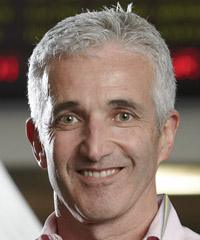 |
When Fyfe joined the company as chief information officer, AirNZ was recovering from near bankruptcy and a taxpayer-funded bail-out. Before his appointment as CEO in 2005, he headed the carrier’s business transformation team and is credited with being a major player in AirNZ’s turnaround.
Throughout his tenure, despite having to contend with high fuel costs and the global financial meltdown, AirNZ punched above its weight and made profits.
While AirNZ is a small carrier by international standards, Fyfe made it an industry leader on several fronts. He was a driver of innovation. These included biofuel test flights and aviation sustainability. AirNZ designed and manufactured its own cabin interiors, now much sought after by other carriers and a lucrative business for the carrier.
Fyfe also was known for his humanitarian contributions to his airline. When an earthquake struck Christchurch in 2011, he was on a plane to the city within two hours. Thereafter he and his emergency team knocked on doors until they were sure all 1,900 employees in the city were safe.
Fyfe received a Lifetime Achievement award from Orient Aviation in 2012.
KAZUO INAMORI
In September, 2012, Japan Airlines (JAL) re-listed on the Tokyo Stock Exchange (TSE). The JAL phoenix rose from the ashes exactly 973 days after it had entered bankruptcy protection in January 2010 and was struck off the TSE rolls.
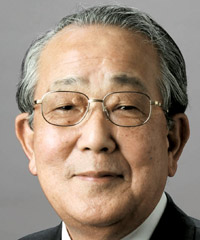 |
Much of the credit for the re-born, substantially leaner JAL went to 78-year-old management guru, Kazuo Inamori, who was invited by the government to sort out the floundering carrier.
When he arrived, Inamori, the founder of high-tech company, Kyocera, didn’t pull his punches. He accused JAL’s management of being “unfit to run a fruit and vegetable stall” and, as the new CEO, set about restructuring the carrier.
Its fleet and routes were slashed. JAL, once the operator of the world’s largest fleet of B747s, now has none. Other gas guzzling planes were sold or grounded.
Its freighter fleet was disbanded. By the end of 2015, one third of its once 47,000 strong workforce (15,700) will have left the company. Pensions have been reduced and those still in work have had their pay cut.
Coordinating the turnaround with Inamori was the government-supported Enterprise Turnaround Initiative Corporation (ETIC), which loaned JAL 350 billion yen (US$ 3.5 billion) while it was in bankruptcy protection. The airline repaid the loan within the required three-year time frame, earlier this year.
Has Inamori’s tough love worked? In the 2012-2013 financial year, JAL posted a profit of 171.6 billion yen, which followed a profit of 186.6 billion yen in the previous 12 months.
Last year, the carrier launched an LCC joint venture, Jetstar Japan, with Qantas Airways.
Today, Inamori’s profit-focused philosophy, printed in his 125-page book, JAL Philosophy, is compulsory reading for employees at all levels.
SHINICHIRO ITO
Much has happened at All Nippon Airways (ANA) since Ito San was appointed president and CEO in 2009, both good and bad. Ito was made chairman of the carrier in February and president of ANA Holdings under a restructuring of the business in which 57 subsidiaries and 19 affiliates were placed under one corporate umbrella.
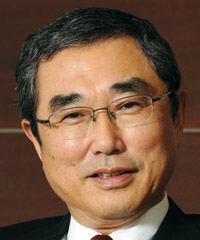 |
But there can be no doubting his low point: the tragic tsunami and earthquake in the northeast of the country in 2011, which led to radio active leaks from the Fukishima power plant. This resulted in the bottom falling out of the Japanese travel market with massive losses for its home airlines.
He also had to contend with the lengthy delays of the B787 Dreamliner, for which ANA was the launch customer with 55 orders. Once they did start to arrive, the global fleet was grounded because of a battery malfunction.
But the 40-year ANA veteran dealt with adversity in a hands-on and statesmanlike fashion. The challenges were outweighed by several high points of Ito’s leadership at the airline.
When he became president of the airline he said he wanted ANA to become Asia’s number one airline. The internationalization of Haneda Airport helped his case as it allowed ANA significant expansion of its international network.
In his first year as president, ANA managed to cut costs by 100 billion yen. This was followed by savings of 87 billion yen in 2010 and 30 billion in 2011. The carrier is expecting another 100 million yen in savings before the end of 2014.
ANA launched two low-cost carrier joint ventures last year. While Peach Aviation is proving to be Japan’s most popular LCC, AirAsia Japan has failed and will fly its final services at the end of the month. ANA will start flying with its wholly-owned LCC, Vanilla Air, by year’s end.
Ito established joint ventures with United Airlines and Lufthansa in 2011.
While all this was going on ANA’s major rival, Japan Airlines, was entering bankruptcy protection and became a shadow of its former self. It allowed ANA to become Japan’s number one carrier.
Ito was not slow in criticizing the Japanese government for pouring millions of tax payers’ dollars into saving JAL while, he said, ANA had achieved its success without a dollar of state aid.
In recent years, Ito has spoken out strongly against Japan’s sky-high infrastructure costs, such as airport landing fees, navigation charges and domestic fuel taxes.
He also created the strategy for the company to become a holding company. Ito received Orient Aviation’s Person of the Year award in 2011.
IDRIS JALA
In 2005, the former Shell executive was headhunted by the Malaysian government to be managing director of its national carrier, Malaysia Airlines’ (MAS). At that time, MAS was close to bankruptcy. It had only three months of operating cash left.
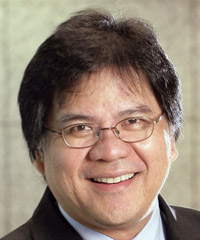 |
Jala was its saviour. Within two years, the airline was recording record profits. Jala slashed jobs at the over-staffed airline and cut routes. He exposed malpractices by introducing a ‘whistle blowers’ programme.
Problem solving? “We stick people in a room and they stay there burning the midnight oil until it is solved,” he said. It was tough love Jala style.
Although he had no previous airline background, his leadership proved inspirational. He left the carrier to join the Malaysia prime minister’s office in 2009. Since then, MAS has slumped back into financial crisis.
Jala received Orient Aviation’s Person of the Year award in 2008.
ALAN JOYCE
Since he joined Qantas Airways in 2000, life has been a roller coaster ride for Joyce. In 2003, he was appointed chief executive of Qantas’ newly formed low-cost subsidiary, Jetstar, which proved an immediate success. Jetstar Asia was established in Singapore in 2006 and brought under the Jetstar brand. An 18% stake was taken in Vietnam’s Pacific Airlines in 2008, which was later re-launched as Jetstar Pacific.
 |
Following his success at Jetstar, Joyce, a no-nonsense Irish businessman with a first class honours degree in mathematics, was elevated to CEO of the Qantas Group in November, 2008. Times have been tough for him ever since.
He has had to contend with major revenue losses on international routes and growing competition within Australia’s own borders from both foreign and local competitors, particularly the Middle Eastern carriers.
As a result, Joyce has restructured the company, retrenching many hundreds of its staff in the process including its engineering arm. He has had long running battles with the unions, which culminated in his decision to ground the entire fleet in November, 2011, leaving thousands of passengers stranded both in Australia and abroad.
In September last year, Joyce stunned the industry when he announced a wide-ranging partnership with rival, Emirates Airline, swapping Qantas’ long-time Singapore hub on its Kangaroo route for Dubai.
Before Joyce joined Qantas, he worked first with Aer Lingus and then with the now-defunct Ansett Australia.
EMIRSYAH SATAR
Former banker Satar, is credited with turning Garuda from a basket-case carrier in the late Nineties into one of Asia’s most profitable and most improved carriers flying today.
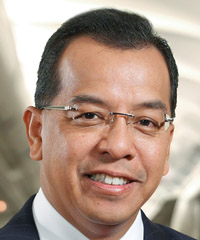 |
Mired in corruption, cronyism and growing debt, Garuda was a pawn of the Suharto regime. When he fell from power, in 1998, the government called in bankers Robby Djohan and, later, Abdulghani, to put the airline back on track. Satar was appointed executive vice-president finance. From 1998 to 2003, he spearheaded a $1.8 billion restructuring programme that saved Garuda from bankruptcy.
He returned to banking, but in 2005 was offered the opportunity to become Garuda’s president. With the airline struggling financially again, initially he rejected the offer, but relented saying: “At the end of the day it was like duty calls.”
His first priority was to operate the carrier with complete transparency. In his first full year in charge Garuda’s annual net loss was reduced over the previous year. It then started to report a series of annual profits. Last year, its net profit was over $145 million, more than twice the 2011 profit. Garuda even held steady during the downturn in 2007-2009 as most other airlines struggled to keep their heads above water.
Satar re-introduced flights to Europe in 2011. Services had been halted in 2004 to cut costs. A fleet upgrade is underway. Sixty five planes will be added to Garuda’s 100-plane fleet in coming years. Satar has completely changed the airline’s image, with a new livery and aircraft interiors.
Satar, who is currently the longest serving CEO of a major Asia-Pacific carrier, received Orient Aviation’s Person of the Year award in 2010.
Other high-flying CEOs
There are many more chief executives who have played their part in the success of the Asia-Pacific in the last 20 years.
One of the longest serving in 1993 was Thai Airways International’s (THAI) CHATRACHAI BUNYA-ANANTA. He became THAI’s first civilian president in 1992, having joined the airline from BOAC in 1971. He stepped down as Orient Aviation launched in October that year and featured in the first issue.
Up to 1976, the airline was 30% owned by SAS. Chatrachai was THAI’s vice-president marketing for 14 years before becoming executive vice-president in 1986.
THAI had made great strides forward in the Eighties and by 1992 was among seven Asia-Pacific carriers in the top 10 most profitable airlines in the world.
But the airline became entangled in clashes between civilian and military factions, an issue that blights the carrier to this day. In his last year, THAI saw its mid-year profit fall 95%, which prompted the popular Chatrachai to admit that maybe he spent too much time on politics and not enough on business.
The late JAMES STRONG made a big impression on Qantas in the Nineties. He joined the airline as managing director in 1993, with a brief to make Qantas attractive to the investment community as it prepared for privatization and a listing on the Australian Stock Exchange. It listed in 1995.
He cleared out the old management and set about restructuring the airline. It did not make him a popular leader. “We were portrayed as destroyers. The confrontation was unbelievable,” he told Orient Aviation in 1999. By the turn of the millennium, Strong had led Qantas to five successive years of profits.
Strong, known for his trademark bow tie, died earlier this year aged 68. Qantas CEO, Alan Joyce, described him as “a giant of Australian aviation and Qantas history”.
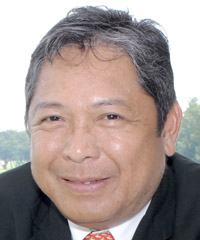 |
JAIME BAUTISTA, who retired as president of Philippine Airlines (PAL) in April last year, was one of the key players in formulating and implementing PAL’s 10-year rehabilitation plan after it went into receivership with $2.3 billion of debt in 1998.
The highly respected Bautista was chief financial officer at the time. He became PAL president in 2004.
He relentlessly drove down costs and improved systems and productivity while coping with soaring oil prices and growing competition from carriers within the country.
In 2006, PAL recorded the largest profit in its history. A few months later it exited rehabilitation two years early.
Bautista implemented a medium-term fleet upgrade the same year, which is reflected in today’s fleet of 46 aircraft with an average age of 9.3 years. Shortly after his retirement, new president, Ramon Ang, announced an order for 54 aircraft, a record for the airline.
In recent years, PAL has been hit by bans on Philippine carriers by both the U.S. and European aviation authorities because of concerns about the country’s aviation safety oversight.
Before his retirement, Bautista fought hard, without success, to have the bans lifted at PAL. Europe gave the airline the green light to resume services earlier this year and the U.S. may soon follow Europe’s example.
Another setback for Bautista before he left PAL was that low-cost rival Cebu Pacific had taken over the majority share of the domestic market. He was Orient Aviation Person of the Year in 2007.
Banker RALPH NORRIS enjoys driving fast cars. But it was his drive off the race track as managing director of AirNZ that was catching the eye in 2002. Norris was drafted into the carrier by the New Zealand government after it had saved the airline from collapse with a $520 million bail-out package. It took 82% control of the carrier.
Norris understood that traditional operating norms at the airline no longer applied and that AirNZ needed to be revolutionized. He started by introducing a single class and lower cost structure to the domestic network. He did the same across the Tasman Sea to Australia.
In his first year he turned the airline around, when it posted a net profit of $97.5 million.
In 2005, Norris left AirNZ and became CEO of the Commonwealth Bank of Australia. He retired in 2011. He became Sir Ralph in 2009 when he became a Knight Companion of the New Zealand Order of Merit for his services to business.
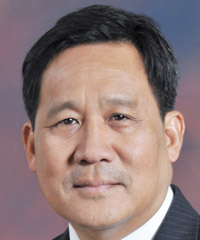 |
PIYASVASTI AMRANAND breezed into the THAI president’s hot seat in October 2009 promising to root out corruption and cronyism and fend off board interference. The board had been effectively managing the airline for five years, said Piyasvasti, shortly after his arrival.
The airline had just suffered its first financial loss in 43 years. Within a year, the new president had restored profitability and accountability.
A former energy minister in the Thai government, he introduced an effective environmental programme to the company, considerably changed the airline’s corporate culture and laid the foundations for THAI’s fleet expansion.
Piyasvasti had negotiated long and hard with the board to ensure his independence in the role before he accepted the job. However, it proved too much for the military and government masters among them. In mid-2012, he was sacked.
The president, in a relatively short time, had won the overwhelming support of his staff and, indeed, the industry at large. The reason for his dismissal? Poor communication with the board, said the chairman.
Alas, Piyasvasti became the latest body to be ‘buried’ in the crowded THAI graveyard of former presidents.
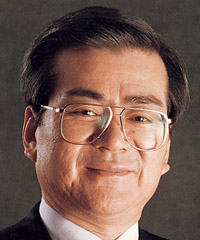 |
When it comes to longevity, Korean Air (KAL) boss, Y. H. CHO has stood the test of time. Indeed, the carrier is very much a ‘family firm’. Maybe dynasty is a better word.
It was founded by his father, C. H. Cho, in 1969. Y.H. joined the airline in 1973. Today, two of his children are senior executives at KAL.
Cho became chairman in 1999 at a time when the carrier suffered a catalogue of serious and less serious accidents. It invested heavily in improving its safety culture and restored its reputation in the new millennium.
KAL is one of the world’s leading cargo airlines, with a fleet of 27 freighters, and was a founding member of the SkyTeam alliance. Among its 146-plane fleet it has three A380s in service with another seven on order.
It launched an LCC, Jin Air, in 2007. In 2013, it acquired a 44% stake in Czech Airlines.
KAL is majority-owned by Korean transport logistics group, Hanjin, of which Cho is also chairman.